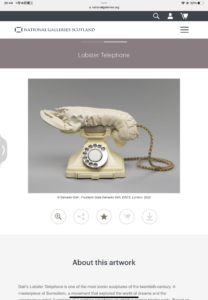During our class , each of our students shared an art organization they had visited and found interesting. It was an engaging session, as we got to learn about each other’s experiences and thoughts.
As for myself, I shared two art organizations with different backgrounds.
Firstly, I would like to talk about the Scottish National Gallery of Modern Art, an open public art museum. It is divided into four different galleries: the Scottish National Gallery, Modern One, Modern Two, and the Scottish National Portrait Gallery. I focused on Modern One, which is a collection of modern and contemporary art. I chose it because I am interested in Surrealism and Dadaism, and I am particularly fascinated by the Lobster Telephone (PIC.1), one of the most iconic Surrealist masterpieces of the 20th century by artists Salvador Dali and Edward James. The upper part of the artwork is a lobster receiver, cleverly designed as a telephone receiver in the shape of a lobster. In the Western world, lobsters are often associated with sex, and it is ironic that the phone is designed to have the user’s mouth positioned right on top of the lobster’s genitals.
The artwork “Lobster Telephone” may seem absurd, but it is thought-provoking.

PIC.1Lobster Telephone from Scottish National Gallery website
Through my interest in art, I have read some literary works to learn more about Surrealism.
Surrealism is a cultural movement originating in Belgium and directly derived from Dadaism. Surrealist works often have strong contrasting and anti-logical features. Surrealist artists view their works not only as art, but also as philosophy and wealth. They often use art to represent human subconsciousness and contradictions in the world, such as life and death.( https://zh.m.wikipedia.org/zh cn/%E8%B6%85%E7%8E%B0%E5%AE%9E%E4%B8%BB%E4
%B9%89 )
Surrealist art challenges traditional ideas of reality and encourages viewers to question their perceptions. It also provides a platform for social and political critique through the use of symbolism and metaphor. This makes it a powerful tool for artists to express their ideas and engage with their audience in a thought-provoking way (Gale, 2019). Artists can express their thoughts “curvilinearly” through surrealist artworks, which may not adhere to logic and common sense. The emotional experience of the audience can also be beyond rational control. Art historian Mary Ann Caws notes, “The surrealists wanted to shock the public into a new awareness of reality, to break down the barriers between conscious and unconscious thought, and to transform everyday life” (Caws, 2013, p. 12). Thus, the strength of Surrealism lies in its ability to challenge conventional ways of thinking and inspire new perspectives on the world around us.
Nevertheless ,the artworks of Surrealism emphasize the world of the subconscious and hallucination, and are often highly personalized and subjective, making them difficult to understand and appreciate by many. For instance, Max Ernst’s artwork “The Elephant Celebes” is considered one of the quintessential examples of Surrealism, yet its symbolism and supernatural elements are not widely comprehensible and accepted (Gale, 2019). Surrealist artists emphasize that their artworks are a form of expression of the subconscious, but these expressions are often very personal and unique, and can only be fully understood and explained under certain backgrounds and conditions (Chadwick, 2007).
Furthermore, Surrealist artworks often lack real-life significance and references. Despite emphasizing the world of the subconscious and hallucination, Surrealism pays little attention to the problems and challenges in real life. For example, Salvador Dalí’s artwork “The Persistence of Memory” displays melting clocks and strange creatures, but these images seem to have little connection with real-life and are unlikely to provide insights for solving real-world issues (Chadwick, 2007).
All in all, the advantage of surrealism is that it breaks free from the constraints of traditional art, goes beyond conventional forms of artistic expression, and creates imaginative works that offer a new visual experience. However, the limitations of surrealism lie in the fact that its works are often too subjective and personal to be widely understood and appreciated. Moreover, these works lack practical significance and reference to reality, and pay little attention to the problems and challenges of real life.

Surrealist painters
Reference
1.Da Feng. (2019). Surrealism. Da Feng Psychology Encyclopedia. https://link.gale.com/apps/doc/CX3746200391/GVRL?u=anon~3d7ae92f&sid=GVRL
2.Cos, M. (2013). The Appearance of Surrealism: The Meeting of Desire. MIT Press.
3.Thames & Hudson. Chadwick, W. (2007). Women, Art, and Society. Thames & Hudson.
4.Gale. (2019). Surrealism. In Gale Psychology Encyclopedia. Retrieved from https://link.gale.com/apps/doc/CX3746200391/GVRL?u=anon~3d7ae92f&sid=GVRL


Leave a Reply